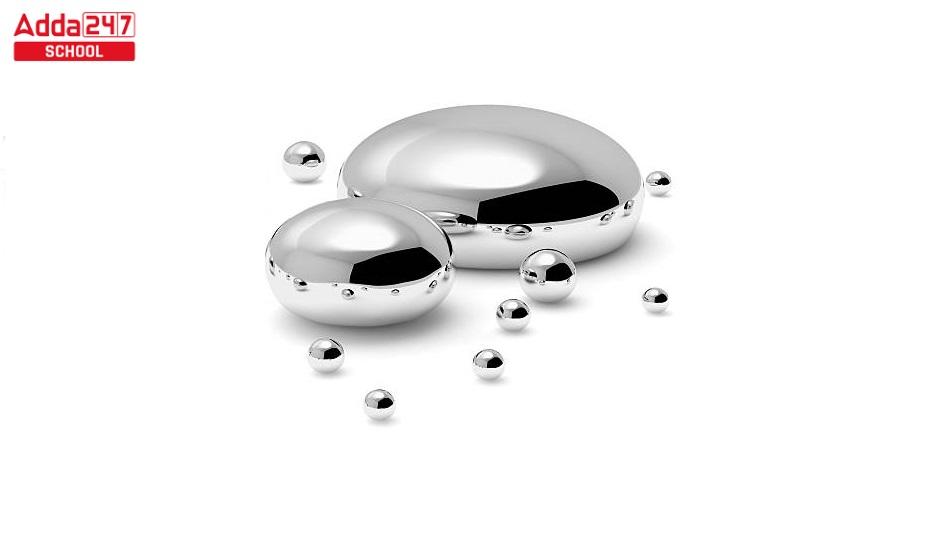Table of Contents
Mercury Definition
The chemical element mercury has the atomic number 80 and the symbol Hg. It was once known as hydrargyrum and goes by the moniker quicksilver. The only other metallic element that is known to be liquid at ordinary temperature and pressure is the halogen bromine, while metals like caesium, gallium, and rubidium dissolve just above ambient temperature. Mercury is a heavy, silvery d-block element. Mercury (Hg), often known as quicksilver, is a chemical element that belongs to Periodic Table Group 12 (also known as Zinc Group IIb).
| atomic number | 80 |
|---|---|
| atomic weight | 200.592 |
| melting point | −38.83 °C (−37.89 °F) |
| boiling point | 356.62 °C (673.91 °F) |
| specific gravity | 13.5 at 20 °C (68 °F) |
| valence | 1, 2 |
| electron configuration | 2-8-18-32-18-2 or (Xe)4f 145d106s2 |
Mercury Density
The density of mercury has been calculated using the Beattie formula based on the aforementioned mean value of density at 20oC. In addition to thermometry, the primary standard barometer and the volume of small capacity measures are both determined using mercury as a reference standard. The density values have been determined in steps of 0.1oC throughout the desired temperature range, which in either case is 0-41oC. Mercury’s density is based on an atmospheric pressure of 101325 Pa.
Sodium Hydroxide, Chemical Formula, Uses, Common Name
Mercury Uses
- Mercury is used in a variety of devices, including thermometers, barometers, manometers, sphygmomanometers, float valves, mercury switches, mercury relays, fluorescent lamps, and others.
- However, due to worries about the element’s toxicity, mercury thermometers and sphygmomanometers have been largely phased out in clinical settings in favour of substitutes like alcohol- or galinstan-filled glass thermometers and thermistor- or Likewise, mercury sphygmomanometers have been replaced with mechanical pressure gauges and electrical strain gauge sensors.
- In some places, amalgam is still used for dental restoration, and mercury is still used in scientific research applications. Additionally, fluorescent lighting uses it.
- Short-wave ultraviolet light is created when electricity is delivered through mercury vapour in a fluorescent lamp. This light then causes the phosphor in the tube to glow, producing visible light.
CaCO3- Chemical & Common Name, Molar & Atomic Mass
Mercury Isotopes
Mercury exists in seven stable isotopes, with 202Hg being the most prevalent (29.86%). The radioactive isotopes 194Hg, with a half-life of 444 years, and 203Hg, with a half-life of 46.612 days, have the longest half-lives. The majority of the radioisotopes that are still in existence have half-lives of under a day. The most often investigated NMR-active nuclei are 199Hg and 201Hg, which have spins of 12 and 32, respectively. The trace isotope 196Hg and the more abundant 198Hg are two stable mercury isotopes that may be of importance for the synthesis of valuable metals.
Mercury Occurrence
Mercury has an average crustal abundance by mass of just 0.08 parts per million, making it a very uncommon element in the Earth’s crust (ppm). Mercury ores can be incredibly concentrated given the element’s abundance in regular rock since it geochemically does not blend with those elements that make up the majority of the crustal mass. Even the leanest concentrated deposits are at least 0.1% mercury, whereas the richest mercury ores can contain up to 2.5% mercury by mass (12,000 times average crustal abundance). It can be discovered as a native metal (rare) or in minerals such as cinnabar (HgS), metacinnabar, sphalerite, corderoite, livingstonite, and others. Hot springs and other volcanic zones are frequent locations of mercury ores.
Atomic Mass of Elements 1 to 30 with Symbol and PDF
Mercury Properties
Physical Properties
- At normal temperature, mercury is a hefty, silvery-white metal that is liquid.
- Mercury is a weak conductor of heat compared to other metals, but a reasonable conductor of electricity.
- Mercury has the lowest freezing and boiling temperatures of any stable metal at 38.83 °C and 356.73 °C, respectively, while preliminary research on copernicium and flerovium have shown that they have even lower boiling points.
- The metallic bonding in mercury is weakened as a result of the relativistic and lanthanide contractions, which reduce the radius of the outermost electrons.
- Mercury loses 3.59% of its volume when it freezes, and its density increases from 13.69 g/cm3 to 14.184 g/cm3 when it becomes a solid.
- The ductile and malleable solid form of mercury can be sliced with a knife.
Atomic Number 1 to 30 Table and List
Chemical Properties
- Although oxidizing acids like strong sulfuric acid, nitric acid, or aqua regia dissolve mercury to produce sulphate, nitrate, and chloride, most acids, including dilute sulfuric acid, do not react with mercury.
- Mercury reacts with the hydrogen sulphide in the air, just like silver does.
- Solid Sulphur flakes are used in mercury spill kits to react with mercury to absorb mercury (spill kits also use activated carbon and powdered zinc).
- The majority of acids, including diluted sulfuric acid, do not react with mercury, despite the fact that oxidizing acids like strong sulfuric acid, nitric acid, or aqua regia dissolve mercury to generate sulphate, nitrate, and chloride.
- Similar to how silver does, mercury also reacts with the airborne hydrogen sulphide.
- In kits for mercury spills, solid Sulphur flakes are used to react with mercury and absorb it (spill kits also use activated carbon and powdered zinc).
What is Electron Configuration of elements?
Mercury Metal or NonMetal
Mercury is a chemical element that occurs naturally. Mercury is found in rock in the earth’s crust and also in deposits of coal. Mercury is named ‘Hg’ in the periodic table with the atomic number 80. It is quicksilver, heavy, silvery-white liquid metal. Mercury is a transition metal. It can neither be created nor destroyed as a chemical element. The density of mercury is 13.6 g.cm-3 at 20°C. Mercury has many useful applications and is an element with properties hazardous to the environment.
What is Mercury Metal?
Mercury is a chemical element with the symbol Hg and atomic number 80. It is also known as quicksilver and was formerly named hydrargyrum. Hydrargyrum is from the Greek word hydor meaning water and argyros meaning silver. It is a heavy silvery d-block element, mercury is the only metallic element that is known to be liquid at standard conditions for temperature and pressure.
Mercury is generally used in thermometers, barometers, manometers, mercury switches, mercury relays, fluorescent lamps, etc. Mercury is used in scientific research and amalgam for dental restoration.
Mercury Metal Density
The density of mercury at 20 degrees Celcius is 13545.848 kg/M3. Mercury is used as a reference stand for determining the volume of small capacity measures and to maintain the primary standard barometer. In either case, the temperature range of interest is 0-41°C, therefore the density has been calculated in steps of 0.1°C. The value for the density of mercury refers to an ambient pressure of 101325 Pa. Mercury has been introduced to mankind for thousands of years. This metal is made from the most important ore called Cinnabar. The Cinnabar release mercury as a vapor when heated, later these vapors are cooled and captured as liquid mercury.
Mercury Metal- Physical Properties
Mercury metal can be frozen and changed into solid at a temperature of -38.85°C and it can be transformed into a gas when boiled at 365.6°C. The major physical properties of Mercury are that it has very high surface tension and very good conductor of electricity.
What is Surface tension? Surface tension is a property of a liquid that makes it act like they are covered with skin. While being a good conductor of electricity, this property is used in mercury switches to turn lights on and off.
Mercury is a good conductor of electricity. In several functional products, this property is used. One such gadget is a mercury switch.
Mercury is a heavy, silver-white metal that is liquid at room temperature.
Mercury Metal- Chemical Properties
Mercury doesn’t react with most acids, including dilute sulfuric acid. Mercury reacts with atmospheric hydrogen sulfide. Mercury reacts with solid sulfur flakes, which are used in mercury spill kits to absorb mercury.
Mercury is dissolved in many metals such as gold and silver to form amalgams.
Mercury readily combines with aluminum to form mercury to form a mercury-aluminum amalgam when the two pure metals come into contact. Since the amalgam destroys the aluminum oxide layer which protects metallic aluminum from oxidizing in-depth, even small amounts of mercury can seriously corrode aluminum. Mercury is not allowed aboard an aircraft under most circumstances because of the risk of it forming an amalgam with exposed aluminum parts in the aircraft.
Mercury Metal Uses in Thermometer
Mercury has several applications, as it has high density. Mercury is used in thermometers, barometers, sphygmomanometers, float valves, mercury switches, mercury relays, fluorescent lamps, and other devices. The uses of Mercury are listed below.
- Calomel-mercurous chloride (Hg2Cl2) is used as a standard in electrochemical measurements and medicine as a purgative.
- Mercuric sulfate has been used as a catalyst in organic chemistry.
- Mercuric oxide is used in skin ointments.
- mercuric chlorides are used as an insecticide such as rat poison.
- Mercury (II) fulminates is a very important compound in the production of explosives and firearms.
Mercury Metal Formula
The chemical element mercury has the atomic number 80 and the symbol and formula are Hg. It was once known as hydrargyrum in Greek, and it also goes by the term quicksilver.
Mercury Metal Colour
Historically known as quicksilver, elemental or metallic mercury is a gleaming, silver-white metal that is liquid at ambient temperature. Older thermometers, fluorescent lamps, and some electrical switches all use it.
Emissions of Mercury Metal Liquid into the Air
When Mercury is released from rock and ends up in the atmosphere and water Mercury becomes a problem for the environment. These emissions can happen naturally. Mercury can be released both by volcanoes and forest fires.
Human activities are responsible for much of the mercury that is released into the environment. The burning of coal, oil, and wood as fuel can cause mercury to become airborne, as can burning wastes that contain mercury.
This airborne mercury can also fall to the ground in the form of raindrops, dust, or simply due to gravity. The amount of mercury deposited in an area depends on how much mercury is released from local, regional, national, and international sources.
Mercury Metal- FAQs
- Is Mercury dangerous to touch?
Ans. Mercury is a harmful or poisonous metal that can be harmful when exposed to people. If mercury is swallowed it will absorb very little in the body.
- How is Mercury found in nature?
Ans. Mercury is rarely present as a pure, liquid metal in nature. Mercury is extracted as Mercury sulfide from Cinnabar ore. Cinnabar deposits have been the source of ores for the commercial exploitation of metallic mercury.
- What is special about mercury elements?
Ans. Mercury is a shiny silver metal that contains highly toxic constituents. Mercury is highly harmful to humans with the symbol Hg.
- What Mercury is used for?
Ans. Mercury is used to produce thermometers, barometers, sphygmomanometers, and other scientific tools.
- When was the element mercury discovered?
Ans. The ancient Chinese, Egyptians, and Hindus understood the properties of Mercury and discovered them in Egyptian tombs dating back to around 1500 BC


 CMAT Exam Date 2024, Admit Card Release ...
CMAT Exam Date 2024, Admit Card Release ...
 JKBOSE 8th Class Result 2024 Out, Check ...
JKBOSE 8th Class Result 2024 Out, Check ...
 NMMS UP Result 2024 OUT, Get Result &...
NMMS UP Result 2024 OUT, Get Result &...














